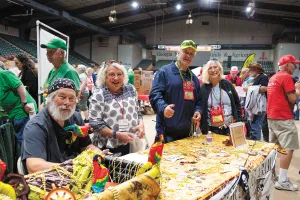A Legendary Texas Trip
Outside Dallas lies a ranch with fluffy friends.
By Ann Bush, F516383
December 2022
What has soft curly fleece, a sweet personality, and big brown eyes in an adorable teddy-bear face; loves to hop; and has not changed much in 9,000 years? South American alpacas — and they have found their way to Texas.

Sometimes confused with llamas, these soft, fuzzy fluffballs are smaller, lighter, and raised for their luxurious fleece.
Early last spring, my feet started itching while waiting for the pandemic to end and safe travel to begin. Not wanting to venture far from my address that is not on wheels, it seemed to be the perfect time to explore Harvest Hosts locations in my home state. The Legendary Alpacas of Texas ranch in Maypearl, Texas, looked fun and inviting. As part of the Harvest Hosts camping network, it was easy to make a reservation, and the drive through the rolling green countryside and historic small towns was pleasant.
The ranch is situated off the beaten track, with an entrance road winding between pastures and barns accompanied by alpacas watching visitors’ every move. At the end of the driveway, a ranch house surrounded by giant oak trees seems to be posing for a greeting card.
Arriving early in the day, I was greeted with a smile by owner Gail Glasscock, who I learned is an alpaca whisperer. She found the perfect place for my RV near the ranch house, with views of the alpacas’ popular pasture and pond. Gail returned to the barn for a few hours to nurse a mama alpaca giving birth, and I opted for a serene stroll through the grounds, with a nearby swimming pool overlooking the valley and a field of grazing female alpacas accompanied by spring newborns a few weeks old. During my walk, I met a nice family from Illinois who were making a return visit. Later, Gail and her nephew eagerly gave me a tour to meet the alpacas face-to-face. It was love at first sight.
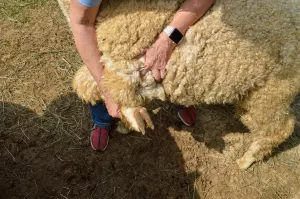
Instead of hooves, alpacas have two toes, with hard toenails on top and soft pads on the bottom.
Originating in Peru, Chile, and Bolivia, alpacas are part of the Camelidae family along with their cousins the camel, vicuna, llama, and guanaco. In ancient times, alpacas and llamas played a crucial role in the economy and survival of the Andean and Incan people by providing food, fuel, clothing, and transportation. It is estimated that over 50 million domesticated alpacas once lived in the Andes mountain range of South America. When the Spanish Conquistadors arrived in the early 16th century, 98 percent of these animals were killed. The few that survived vanished into the mountains and interbred with llamas, creating a two-coated fleece that helped the animals survive the extreme cold of higher elevations.
Today, this double-ply fleece is highly valued by the fiber market for blankets, clothing, and rugs. Many prefer the fleece to wool, because it is hypoallergenic, dries faster, feels softer against skin, and is said to be easier to work with when hand spinning. Known as the “super” fiber, alpaca fleece is naturally windproof; flame-resistant; and will not pill, melt, or hold stains. A few of the ranch’s alpacas have fleece that’s exceedingly soft and in high demand by fiber artists and weavers around the United States. The fleece is rarely dyed, as the natural color is valuable to weavers. Alpaca fleece is an important component of the farm’s income.
A yearly shearing is not painful to the animals. In early April, trained shearers are hired to care-fully remove the fleece. Alpaca fleece grows somewhat like human hair. Removing the fleece just before summer prevents heat stress, and it grows back for protection from cold winters. The ranch allows spectators on specially priced tours (reservations required) to watch the shearing from a safe distance.
The Alpaca Footprint
Fleece is not the only reason Devin and Gina Glasscock began raising alpacas 16 years ago. The Glasscocks are advocates of protecting their Texas ranch land, and their alpacas leave almost no harmful environmental footprint.
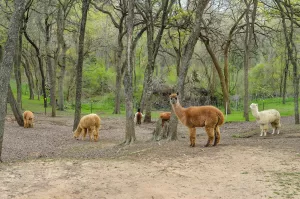
Similar to other livestock species, alpacas thrive in herds. Although social, intelligent, and curious, they do not make good pets.
Much has been written about the harmful effects of cattle on the environment and the link to climate change, resulting in evidence-based research on the environmental impact of the camelid species. The result: Alpacas are possibly one of the most eco-friendly animals on the planet, starting with their eating habits. Alpacas require less water and pasture than cattle. Alpacas have soft footpads and hard toenails, which causes less damage to the land. Instead of hard hooves packing the earth, alpacas stir up the ground and create pockets that trap moisture, retaining a naturally green and nutritious pasture.
Following the practices of South American alpaca farmers, everything the animal produces is used — right down to their manure, which is high in nitrogen and potassium, making it good for composting. They are even considerate by forming “dung piles” in pastures to keep their feet clean.
The Champions
The Legendary Alpacas of Texas ranch is well-known as a trust-worthy alpaca breeding institution, as evidenced by the Glasscocks’ many awards won in shows around the United States. Alpacas come in 22 colors, and fleece characteristics vary slightly between shades. There-fore, competitions correlate to the quality and color of the fleece. Many alpaca herds have sprung up around Texas ranches in the past decade, and the Glasscock family is an important resource for them. “It is important to buy alpacas or use males for breeding purposes that are registered and meet the requirements set by national standards,” Gail emphasized.
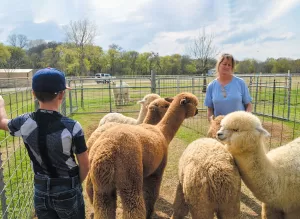
The ranch’s award-winning huacaya alpacas are the stars of the show.
The Legendary Alpacas ranch is a member of the Alpaca Owners Association (AOA), which oversees an internationally recognized pedigree registry, an alpaca show system, and a judge training program. Education for current and prospective alpaca owners is offered as well, along with a system to ensure the animals are treated with care and proper dignity. In addition to training for new farmers, the Glasscocks offer internships, which are popular among young Texans in agricultural training. I met a high school student who plans to be a veterinarian and was busily working in the shearing barn. “Education, training, and just good ol’ advice are always available,” Gail said.
She was proud to show off her champions. I met Angiolo, the most famous star at the farm. He has won a wall of numerous awards during his lifetime. This beautiful light-beige showstopper is the most sought after for breeding purposes. Snowmass Royal is a rich-chocolate alpaca who has won seven color championships, five reserve championships, and 13 first-place awards. Legendary Eclipse is a younger true-black alpaca, winning two color championships and six first-place awards so far. Tuscan’s Galliano di Bella Vita is fawn-colored and has won five color championships with 10 first placements. The awards were won at various shows, including the AOA National Fleece Show and the Houston Livestock Show.
Everyone falls in love with these sweet animals, but they do not make good pets. Alpacas are very smart and easy to train, but they are true livestock animals with herding instincts and require socialization with other alpacas. Generally living between 15 and 20 years, alpacas require routine care typical of other domestic farm animals with fleece. The animals consume at least two pounds of grass a day and must be moved to different fields occasionally or their diet supplemented with hay when necessary.

A bird ball.
Art And Fiber
The Legendary Alpacas of Texas’ fleece is organic, sustainable, and biodegradable. Alpaca fleece is softer than cashmere and warmer than wool, so its most popular use is for winter clothing, but it does not stop there. Other uses include home insulation, duvets, dryer balls, pet leashes, saddle blankets, toys, and one of my favorite items: bird balls. Fleece from younger alpacas may not be of the highest quality, so Gina takes small tufts of raw fleece and stuffs it in between the spaces of a grapevine ball. The fleece does not retain water, so it resists mold and naturally repels insects, making it a safe nesting material and just what nesting birds are looking for every spring.
The gift store at the ranch offers numerous items made by fiber partners with fleece from Legendary Alpacas, which Gina can sometimes trace by the color to the very alpaca. Classes are offered on how to make bird balls, to dye fleece, to spin fleece into yarn, or to weave rugs.
Alpaca Tours And Events
Everyone loves horses, cute little goats, and big-eyed calves. But to someone small and very young, these animals could be quite intimidating. Alpacas are much gentler and shy, even as adults. They don’t head butt or bite. In fact, they don’t even have upper teeth. Like their llama cousins, alpacas are not strong enough to ride, and tours are limited to petting or feeding them with a special container safe for little fingers.

Chickens, guinea hens, turkeys, ducks, horses, and dogs also call the ranch home.
The public is allowed in or near the pens only when accompanied by a ranch guide. Group birthday events allow children to party with the champions, customized to the children’s delight and the parents’ budget. A one-on-one alpaca trail walk is available for an extraordinary experience. The Legendary Alpacas of Texas ranch also raises chickens, turkeys, and guinea hens, with expanded tours available to give children the full farm experience.
If You Go
The Legendary Alpacas of Texas ranch house is the cornerstone to a nice circular driveway where visiting RVs are parked. The size of the RVs staying on a particular night determines how many spots are available. All sites are hard-packed dirt; flat; and shaded with views of ponds, pastures, and barns. For information about the Harvest Hosts camping network (which offers a discounted annual membership in partnership with FMCA), visit harvesthosts.com. Or review the ranch’s options and prices directly on their website at www.legendaryalpacas.com.
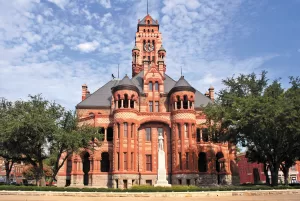
The historic Ellis County Courthouse in nearby Waxahachie is composed of mostly pink granite and red sandstone.
Nearby Attractions
The quaint and humble town of Waxahachie is within 15 miles of the Legendary Alpacas ranch. The city’s early prosperity remains in its historic downtown and 19th-century Victorian homes, earning its nickname as the “Gingerbread City.” Approximately 20 percent of the Texas buildings listed on the National Register of Historic Places are in Waxahachie.
Worth a leg-stretch break is a tour of the striking Ellis County Courthouse, constructed in 1897 and recently restored to its original Romanesque Revival architecture. Because of the picturesque homes and the beautiful courthouse square, the building was a backdrop for the Academy Award-winning Bonnie and Clyde and Tender Mercies films. If you’re traveling in the summer, consider stopping by the Crape Myrtle Festival in July, when the historic streets are lined with bright pink crape myrtle trees in full bloom. For more information about the town, review the Waxahachie Convention & Visitors Bureau website at www.waxahachiecvb.com.
The post A Legendary Texas Trip appeared first on Family RVing Magazine.
Source: https://familyrvingmag.com/2022/12/01/a-legendary-texas-trip/


